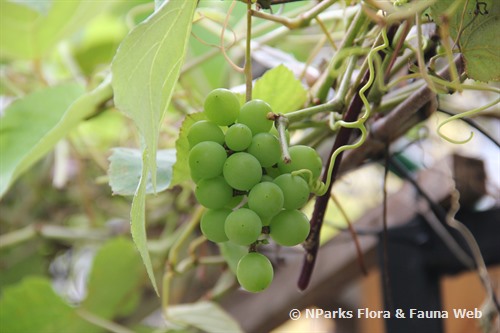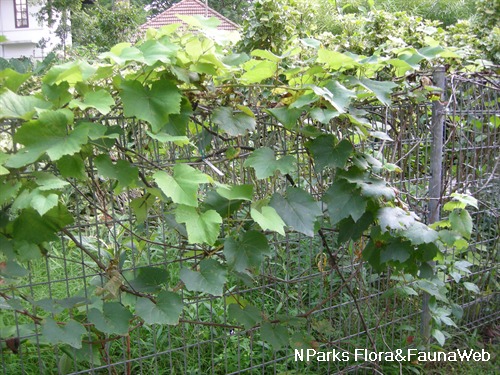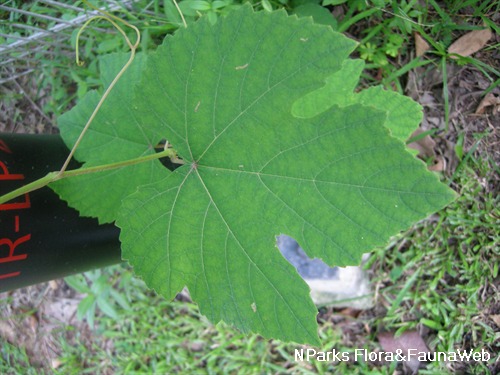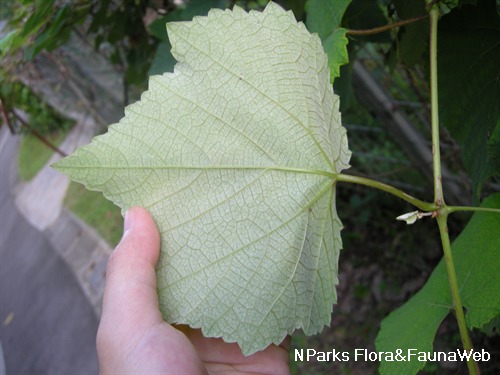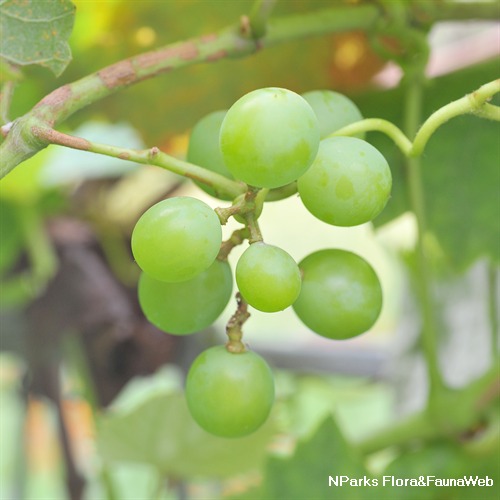.jpg)
Name
Classifications and Characteristics
| Plant Division | Angiosperms (Flowering Seed Plants) (Dicotyledon) |
|---|---|
| Plant Growth Form | Climber |
| Lifespan (in Singapore) | Perennial |
| Mode of Nutrition | Autotrophic |
| Chromosome Number | 38 |
Biogeography
| Native Distribution | North-eastern Afghanistan to southern borders of the Black Sea and Caspian Sea. |
|---|---|
| Native Habitat | Terrestrial |
| Local Conservation Status | Non-native (Horticultural / Cultivated Only) |
Description and Ethnobotany
| Growth Form | A vigorous woody climber with a twining growth habit, it can grow up to 15 to 20m in length. |
|---|---|
| Foliage | The leaves have specialized functions as tendrils and are forked and produced intermittently opposite the leaves. The leaves are simple, 5 to 25cm wide, palmately lobed and coarsely toothed along the leaf margin. The leaf underside is a pale white. |
| Flowers | The flowers are borne on dense thryses and are fragrant. |
| Fruit | The edible fruit is a berry and come in dark blue-purple, red, green or yellow and are sweet or sour to the taste. Each fruit contains 3 to 4 pyriform (pear shaped) seeds. |
| Cultivation | It is ideally grown under full sun, in light, well drained soils. The growing media should be deep so as to accommodate the deep root system. It cannot tolerate flooding and waterlog. Ideal soil pH levels would be from 5.0 to 8.0 with pH levels slightly below 7.0 as the optimal pH level. The optimal temperature is 25 to 30°C. The plant is best grown on trellises to support its climbing habit. To prevent legginess of the canes and increase longevity, the apical tips of the canes should be pinched off to force lateral shoots to grow, giving a bushier appearance. |
| Ethnobotanical Uses | Edible Plant Parts : Edible Fruits Food (Fruit or Vegetable): The juice extracted from the fruit is fermented and made into wine or drunk as fresh fruit juice. The sweet fruit is also eaten as table grapes. |
Landscaping Features
| Desirable Plant Features | Ornamental Foliage |
|---|---|
| Landscape Uses | Parks & Gardens, Small Gardens, Trellis / Arbour / Pergola |
| Thematic Landscaping | Economic Garden |
Plant Care and Propagation
| Light Preference | Full Sun |
|---|---|
| Water Preference | Moderate Water |
| Plant Growth Rate | Moderate |
| Rootzone Tolerance | Well-Drained Soils |
Foliar
| Foliage Retention | Evergreen |
|---|---|
| Mature Foliage Colour(s) | Green |
| Foliar Arrangement Along Stem | Alternate |
| Foliar Attachment to Stem | Petiolate |
| Foliar Shape(s) | Non-Palm Foliage |
| Foliar Venation | Pinnate / Net |
| Foliar Margin | Serrate / Toothed |
Floral (Angiosperm)
| Flower Colour(s) | Green, Yellow / Golden |
|---|---|
| Flower Grouping | Cluster / Inflorescence |
| Inflorescence Type | Thryse |
Fruit, Seed and Spore
| Mature Fruit Colour(s) | Purple, Red, Yellow / Golden |
|---|---|
| Mature Fruit Texture(s) | Smooth |
| Fruit Classification | Simple Fruit |
| Fruit Type | |
| Mature Seed Texture(s) | Smooth |
| Seed Quantity Per Fruit | Few (1-5) |
Image Repository
Others
| Master ID | 31425 |
|---|---|
| Species ID | 5822 |
| Flora Disclaimer | The information in this website has been compiled from reliable sources, such as reference works on medicinal plants. It is not a substitute for medical advice or treatment and NParks does not purport to provide any medical advice. Readers should always consult his/her physician before using or consuming a plant for medicinal purposes. |

.jpg)
.jpg)

